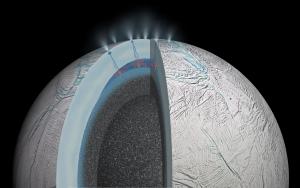Blog
Water, Water, Every Where
15 March 2015
 NASA/JPL-Caltech
NASA/JPL-CaltechWe normally think of Earth as the “water world” of the solar system. While it’s true that Earth seems to be the only planet with liquid water on its surface, it isn’t the only world with water, nor is it the one with the most water. In the past we thought that Earth was the only planet with liquid water, but even that’s changing. As we’ve sent probes to the outer planets, we’ve found that many moons show evidence of liquid water in their interiors. It may be that liquid water is most common in the outer solar system. Take, for example, Saturn’s moon Enceladus.1
Enceledus is a small moon, only about 500 km in diameter. We’ve known for a while that it is geologically active, since we’ve observed active cryovolcanoes in the southern hemisphere. Given its size, this activity is likely driven by tidal effects from Saturn. But new evidence shows that not only is there liquid water within Enceledus, it is most likely warm. This comes from observations of the moon’s cryovolcanic plumes gathered by the Cassini probe. It seems that the plumes not only contain saline water, but also silica. The origin of this silica is not entirely clear, but its likely that it dissolved in the subsurface water before it was ejected. If that’s the case, the water would only only need to be in contact with rock, but also at a temperature of about 160 degrees Celsius.
There’s a scenario that could produce warm water in contact with rock, and that’s a geothermal vent, such as has been observed on Earth. This has raised speculation about whether Enceledus could harbor life, since thermal vents on Earth are known to be rich with life. One should be cautious in speculating too far in that direction. For one, though the thermal vent model is a likely cause, it isn’t a confirmed cause. We’ll need more observational data to confirm that. For another, the fact that Earth vents are rich with life doesn’t mean that extraterrestrial vents will also have life. It might be possible for life to survive there, but not for abiogenesis to occur.
Still, evidence of warm liquid water on outer moons is growing, and that means there are areas in the solar system beyond Earth where life as we know it could survive and thrive. It may just happen that the best place to look for life on another world might not be Mars, but rather the icy moons of Saturn and Jupiter.
Hsu, Hsiang-Wen, et al. “Ongoing hydrothermal activities within Enceladus.” Nature 519.7542 (2015): 207-210. ↩︎